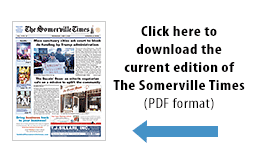By William C. Shelton
 (The opinions and views expressed in the commentaries of The Somerville News belong solely to the authors of those commentaries and do not reflect the views or opinions of The Somerville News, its staff or publishers.)
(The opinions and views expressed in the commentaries of The Somerville News belong solely to the authors of those commentaries and do not reflect the views or opinions of The Somerville News, its staff or publishers.)
Last month, Taeko Minigishi and Wig Zamore were setting up nitrogen dioxide monitors at the corner of Vermont and Michigan Avenues. Three neighbors out for a walk stopped to chat. When Wig and Taeko explained what they were doing, the passersby began pointing out surrounding homes where their neighbors had died from lung cancer.
Thirty-five years ago, some of those neighbors since killed by cancer, like Joe Lapiana, had been active in Somerville Citizens for Adequate Transportation (SCAT). The group had resisted construction of I-93. They knew that the interstate would cut apart their community, displacing neighbors’ homes and boosting noise and air pollution.
They did not know that the administration of Governor John Volpe, who later became U.S. Secretary of Transportation, had commissioned and then suppressed a study forecasting air pollution increases ten times greater than federally allowable standards. Nor could they know that over 10,000 scientific research papers would subsequently determine that ultrafine particles created by auto exhausts are far more lethal than the regulated air pollutants. And unlike regulated pollutants, ultrafines’ impacts are largely on people living and working only a few hundred yards from a busy roadway.
Wig and Taeko’s work that day was the outcome of a decades long struggle begun by SCAT and continued by the Mystic View Task Force. A year ago, peace broke out between Mystic View and the Assembly Square Market Place’s new owner, Federal Realty Investment Trust (FRIT). As part of the settlement, FRIT committed $50,000 to measure the impacts of increased auto traffic on air breathed by East Somerville, Winter Hill, and Ten Hills residents.
Somerville has had the highest excess death rate per square mile from cancer and heart attacks of all Massachusetts cities and towns. The cities and Boston neighborhoods that closely follow Somerville in this distinction are those closest to the roadways and facilities that produce the most ultrafine particles.
Within 100 meters of a roadway, there are up to 1.6 million particles in a cubic inch of air. These ultrafines pass through the mucous membranes that capture larger particles. They enter the lungs, where the chemicals that white blood cells mobilize to destroy invaders overproduce and destroy air sacs as well. They interfere with genetic instructions telling dividing lung cells how to grow, producing cancers.
The finest particles enter the blood stream. They stimulate nerve fibers, sending signals that change the heart’s autonomic balance. Throughout the cardiovascular system, they stimulate production of inflammatory agents that create blood vessel plaque buildup and sclerosis. And they reduce oxidization within human cells.
As with so much in science, it has taken decades to achieve consensus on these matters. In 1993, Harvard School of Public Health researchers published a study comparing air quality to public health in six cities. It found that people living in areas with the most airborne fine particles died, on average, two years earlier than the rest of the U.S. These results were so astounding that the researchers themselves were skeptical.
The American Cancer Society had a database containing 16-year health histories for 1.2 million people. A 1995 analysis of these records confirmed the six-city results and produced a surprise — fine particles were associated with heart attacks even more than lung cancer. Thousands of additional studies have confirmed and quantified these results.
Harvard School of Public Health faculty continue to be central to this research. Professor Jack Spengler, for example, was a coauthor of the 1993 six-cities study. Along with Professor John McCarthy, Spengler formed Environmental Health and Research, the firm conducing the Somerville study. Taeko Minigishi is an EH&E researcher. In the study’s next phase, a van filled with millions of dollars worth of equipment will drive Somerville streets, precisely quantifying mobile gases and fine particle composition in our air.
After years of argument about the impacts of traffic on breathers in eastern Somerville, we will know exactly what is in our air. We will also establish a baseline for measuring the impacts of traffic generated by future development.
When I was a kid in California, we joked that Los Angeles was the only U.S. city where you could wake up every morning of the year and hear the birds…coughing. Since that time, California has led the nation in efforts to reduce air pollution. Just last week, the EPA rebuffed Governor Arnold Swartzenegger’s attempt to reduce greenhouse gas emissions in auto exhaust. Because of the research demonstrating the health impacts of ultrafine particles, California no longer allows construction of schools within 500 feet of a busy roadway.
The place to begin any such policy is, or course, with hard evidence rather than argument and speculation. The study that EH&E is conducting in Somerville will provide us with some hard data. When the results are available, the Somerville News will report them.















Reader Comments